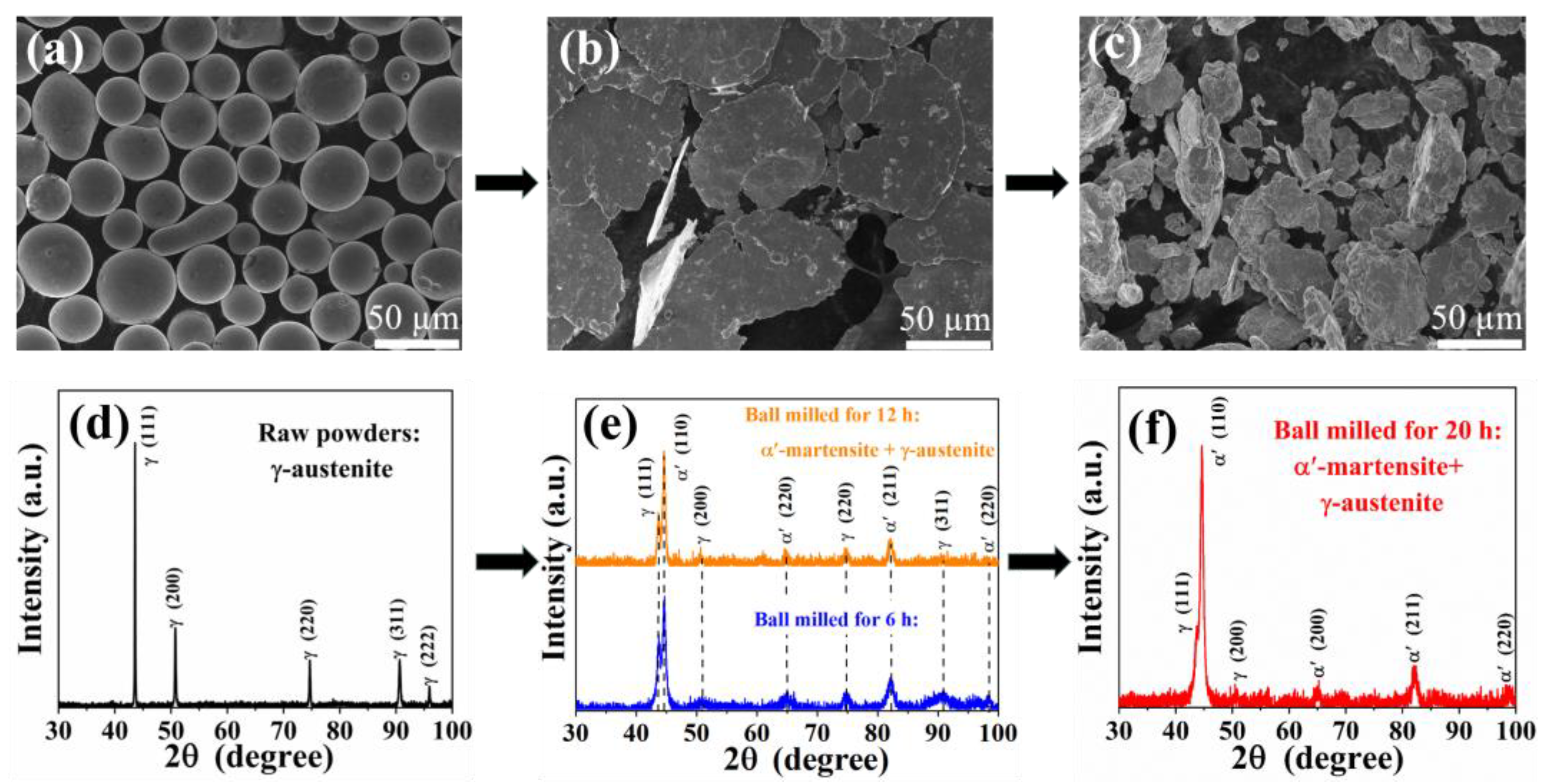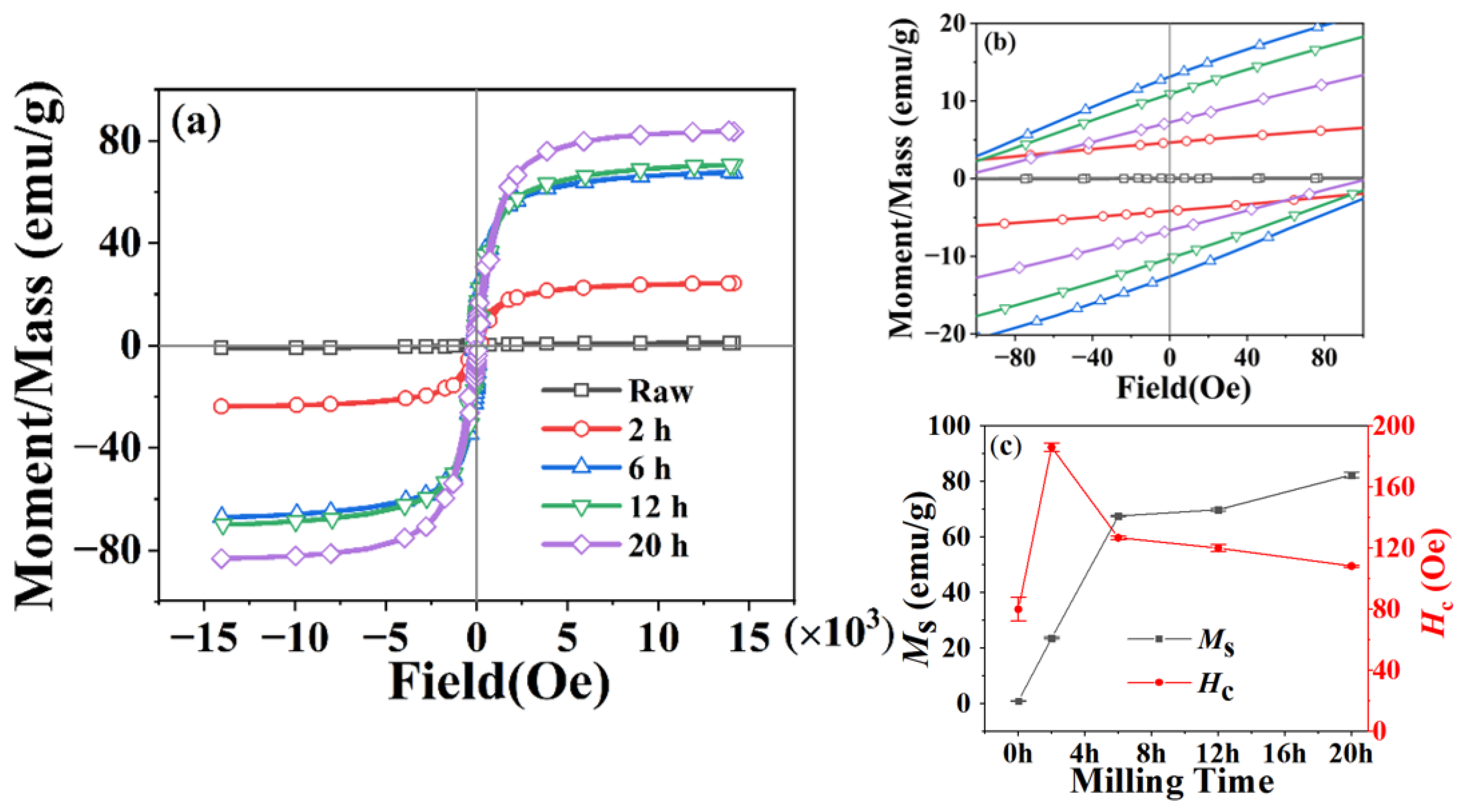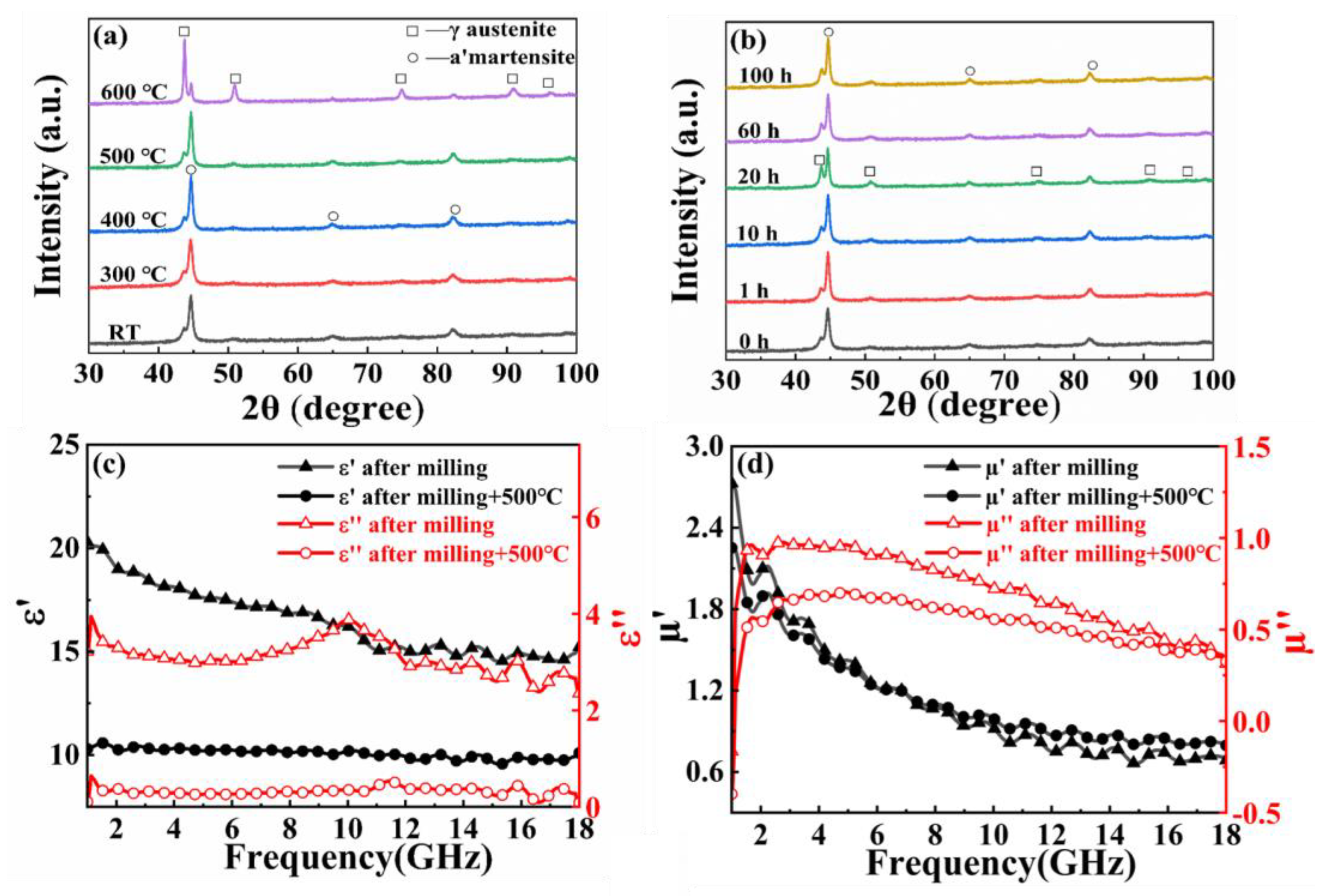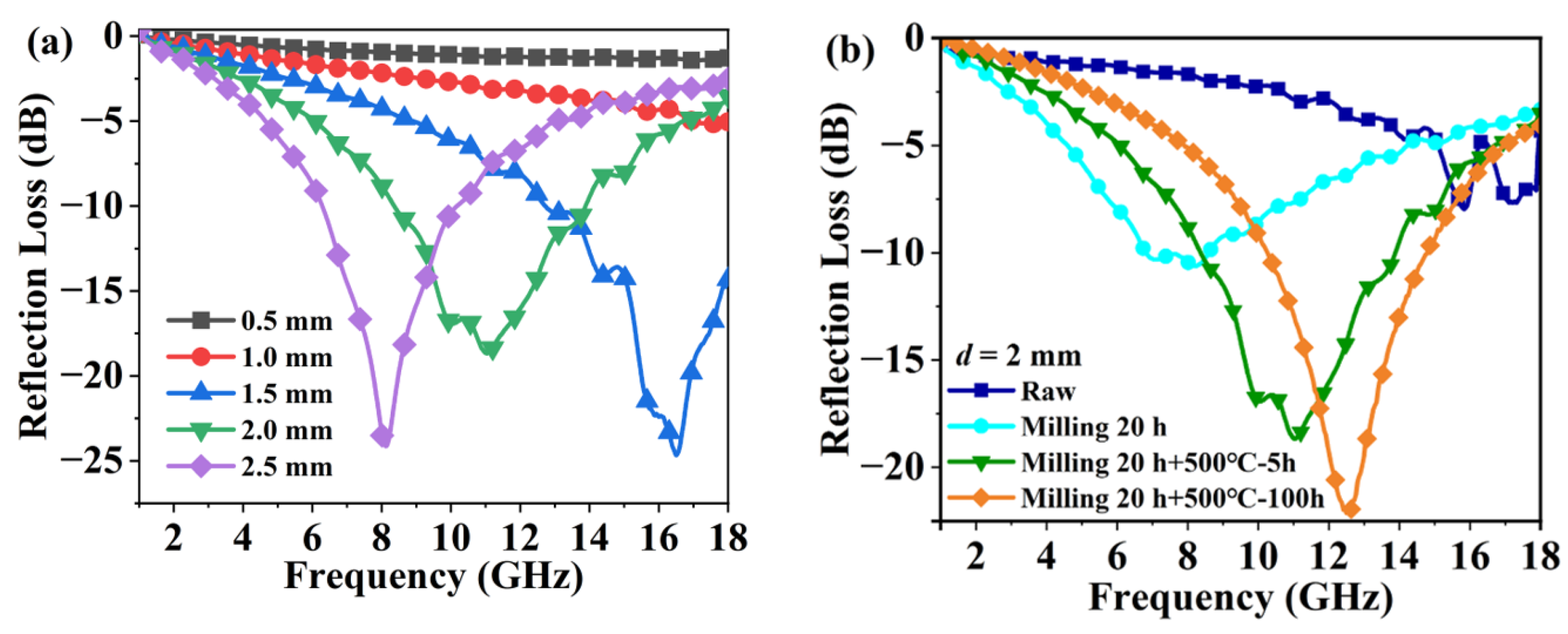Electromagnetic Property Modulation of Flaky Ferromagnetic 304 Stainless-Steel Powders for Microwave Absorption at Elevated Temperatures
Abstract
:1. Introduction
2. Materials and Methods
3. Results and Discussion
4. Conclusions
Supplementary Materials
Author Contributions
Funding
Data Availability Statement
Acknowledgments
Conflicts of Interest
References
- Ding, D.H.; Luo, F.; Zhou, W.C.; Shi, Y.M.; Zhou, L. Research Status and Outlook of High Temperature Radar Absorbing Materials. J. Inorg. Mater. 2014, 29, 461–469. [Google Scholar]
- Wen, B.; Cao, M.; Lu, M.; Cao, W.; Shi, H.; Liu, J.; Wang, X.; Jin, H.; Fang, X.; Wang, W. Reduced graphene oxides: Light-weight and high-efficiency electromagnetic interference shielding at elevated temperatures. Adv. Mater. 2014, 26, 3484–3489. [Google Scholar] [CrossRef]
- Fu, Z.Y.; Pang, A.M.; Luo, H.; Zhou, K.C.; Yang, H.T. Research progress of ceramic matrix composites for high temperature stealth technology based on multi-scale collaborative design. J. Mater. Res. Technol. 2022, 18, 2770–2783. [Google Scholar] [CrossRef]
- Qin, F.; Brosseau, C. A review and analysis of microwave absorption in polymer composites filled with carbonaceous particles. J. Appl. Phys. 2012, 111, 061301. [Google Scholar] [CrossRef]
- Shen, Z.Z.; Chen, J.H.; Li, B.; Li, G.Q.; Zhang, Z.J.; Hou, X.M. Recent progress in SiC nanowires as electromagnetic microwaves absorbing materials. J. Alloys Compd. 2020, 815, 152388. [Google Scholar] [CrossRef]
- Li, D.; Jia, D.; Yang, Z.; Zhou, Y. Principles, design, structure and properties of ceramics for microwave absorption or transmission at high-temperatures. Int. Mater. Rev. 2022, 67, 266–297. [Google Scholar] [CrossRef]
- Jia, Z.; Lin, K.; Wu, G.; Xing, H.; Wu, H. Recent progresses of high-temperature microwave-absorbing materials. Nano 2018, 13, 1830005. [Google Scholar] [CrossRef]
- Sista, K.S.; Dwarapudi, S.; Kumar, D.; Sinha, G.R.; Moon, A.P. Carbonyl iron powders as absorption material for microwave interference shielding: A review. J. Alloys Compd. 2021, 853, 157251. [Google Scholar] [CrossRef]
- Song, W.L.; Cao, M.S.; Hou, Z.L.; Yuan, J.; Fang, X.Y. High-temperature microwave absorption and evolutionary behavior of multiwalled carbon nanotube nanocomposite. Scr. Mater. 2009, 61, 201–204. [Google Scholar] [CrossRef]
- Li, J.S.; Huang, H.; Zhou, Y.J.; Zhang, C.Y.; Li, Z.T. Research progress of graphene-based microwave absorbing materials in the last decade. J. Mater. Res. 2017, 32, 1213–1230. [Google Scholar] [CrossRef]
- Wang, F.; Long, C.; Wu, T.L.; Li, W.; Chen, Z.H.; Xia, F.J.; Wu, J.S.; Guan, J.G. Enhancement of low-frequency magnetic permeability and absorption by texturing flaky carbonyl iron particles. J. Alloys Compd. 2020, 823, 153827. [Google Scholar] [CrossRef]
- Wei, H.Y.; Zhang, Z.P.; Hussain, G.; Zhou, L.S.; Li, Q.; Ostrikov, K. Techniques to enhance magnetic permeability in microwave absorbing materials. Appl. Mater. Today 2020, 19, 100596. [Google Scholar] [CrossRef]
- Saber, M.; Kotan, H.; Koch, C.C.; Scattergood, R.O. Thermal stability of nanocrystalline Fe-Cr alloys with Zr additions. Mater. Sci. Eng. A-Struct. Mater. Prop. Microstruct. Process. 2012, 556, 664–670. [Google Scholar] [CrossRef]
- Lezaic, M.; Mavropoulos, P.; Blugel, S. First-principles prediction of high Curie temperature for ferromagnetic bcc-Co and bcc-FeCo alloys and its relevance to tunneling magnetoresistance. Appl. Phys. Lett. 2007, 90, 082504. [Google Scholar] [CrossRef]
- Yuan, D.C.; Chen, Z.Y.; Cai, C.W.; Yang, B.L.; Wang, Y.J.; Chen, Z.H. Microstructures, absorption and adhesion evolution of FeCoCr/silicone resin coatings at elevated temperature. Front. Mater. 2023, 10, 1168418. [Google Scholar] [CrossRef]
- Fu, Z.W.; Chen, Z.H.; Wang, R.; Xiao, H.Y.; Wang, J.; Yang, H.; Shi, Y.T.; Li, W.; Guan, J.G. Deformation-Thermal Co-Induced Ferromagnetism of Austenite Nanocrystalline FeCoCr Powders for Strong Microwave Absorption. Nanomaterials 2022, 12, 2263. [Google Scholar] [CrossRef]
- Gómez-Polo, C.; Pérez-Landazabal, J.; Recarte, V.; Campo, J.; Marín, P.; López, M.; Hernando, A.; Vázquez, M. High-temperature magnetic behavior of FeCo-based nanocrystalline alloys. Phys. Rev. B 2002, 66, 012401. [Google Scholar] [CrossRef]
- Yin, C.L.; Fan, J.M.; Bai, L.Y.; Ding, F.; Yuan, F.L. Microwave absorption and antioxidation properties of flaky carbonyl iron passivated with carbon dioxide. J. Magn. Magn. Mater. 2013, 340, 65–69. [Google Scholar] [CrossRef]
- Zhou, Y.Y.; Xie, H.; Zhou, W.C.; Ren, Z.W. Enhanced antioxidation and microwave absorbing properties of SiO2-coated flaky carbonyl iron particles. J. Magn. Magn. Mater. 2018, 446, 143–149. [Google Scholar] [CrossRef]
- Xu, Z.G.; Du, J.H.; Wang, J.; Chen, Z.H.; Lie, W.J.; Wang, C.B.; Shen, Q. A comparative study on the microwave absorption properties of core-single-shell, core-double-shell and yolk-shell CIP/ceramic composite microparticles. J. Magn. Magn. Mater. 2022, 547, 168959. [Google Scholar] [CrossRef]
- Abshinova, M.A.; Kazantseva, N.E.; Saha, P.; Sapurina, I.; Kovarova, J.; Stejskal, J. The enhancement of the oxidation resistance of carbonyl iron by polyaniline coating and consequent changes in electromagnetic properties. Polym. Degrad. Stab. 2008, 93, 1826–1831. [Google Scholar] [CrossRef]
- Jia, K.; Xu, M.Z.; Zhao, R.; Liu, X.B. Chemically bonded iron carbonyl for magnetic composites based on phthalonitrile polymers. Polym. Int. 2011, 60, 414–421. [Google Scholar] [CrossRef]
- Yan, L.; Wang, J.; Han, X.; Ren, Y.; Liu, Q.; Li, F. Enhanced microwave absorption of Fe nanoflakes after coating with SiO2 nanoshell. Nanotechnology 2010, 21, 095708. [Google Scholar] [CrossRef]
- Guo, Y.; Jian, X.; Zhang, L.; Mu, C.; Yin, L.; Xie, J.; Mahmood, N.; Dou, S.; Che, R.; Deng, L. Plasma-induced FeSiAl@ Al2O3@ SiO2 core–shell structure for exceptional microwave absorption and anti-oxidation at high temperature. Chem. Eng. J. 2020, 384, 123371. [Google Scholar] [CrossRef]
- Zhao, D.; Luo, F.; Zhou, W.C.; Zhu, D.M. Complex Permittivity and Microwave-Absorbing Properties of Fe/Al2O3 Coatings by Air Plasma Spraying Technique. Int. J. Appl. Ceram. Technol. 2013, 10, E88–E97. [Google Scholar] [CrossRef]
- Wang, H.Y.; Zhu, D.M.; Zhou, W.C.; Luo, F. Enhanced microwave absorbing properties and heat resistance of carbonyl iron by electroless plating Co. J. Magn. Magn. Mater. 2015, 393, 445–451. [Google Scholar] [CrossRef]
- Jia, S.; Luo, F.; Qing, Y.C.; Zhou, W.C.; Zhu, D.M. Electroless plating preparation and microwave electromagnetic properties of Ni-coated carbonyl iron particle/epoxy coatings. Phys. B-Condens. Matter 2010, 405, 3611–3615. [Google Scholar] [CrossRef]
- Chen, Z.H.; Hwang, S.H.; Zeng, X.B.; Roh, J.; Jang, J.; Ungar, G. SAXS characterization of polymer-embedded hollow nanoparticles and of their shell porosity. J. Appl. Crystallogr. 2013, 46, 1654–1664. [Google Scholar] [CrossRef]
- Chen, Z.H.; Kim, C.; Zeng, X.B.; Hwang, S.H.; Jang, J.; Ungar, G. Characterizing Size and Porosity of Hollow Nanoparticles: SAXS, SANS, TEM, DLS, and Adsorption Isotherms Compared. Langmuir 2012, 28, 15350–15361. [Google Scholar] [CrossRef]
- May, J.E.; Galerie, A.; Busquim, T.P.; Kuri, S.E. High temperature oxidation behavior of FeCo-based nanocrystalline alloys. Mater. Corros. -Werkst. Und Korros. 2007, 58, 87–91. [Google Scholar] [CrossRef]
- Gupta, R.K.; Raman, R.K.S.; Koch, C.C. Fabrication and oxidation resistance of nanocrystalline Fe10Cr alloy. J. Mater. Sci. 2010, 45, 4884–4888. [Google Scholar] [CrossRef]
- Cao, G.J.; Geng, L.; Zheng, Z.Z.; Naka, M. The oxidation of nanocrystalline Ni3Al fabricated by mechanical alloying and spark plasma sintering. Intermetallics 2007, 15, 1672–1677. [Google Scholar] [CrossRef]
- Nova, K.; Novak, P.; Prusa, F.; Kopecek, J.; Cech, J. Synthesis of Intermetallics in Fe-Al-Si System by Mechanical Alloying. Metals 2019, 9, 20. [Google Scholar] [CrossRef]
- Lo, K.H.; Shek, C.H.; Lai, J.K.L. Recent developments in stainless steels. Mater. Sci. Eng. R-Rep. 2009, 65, 39–104. [Google Scholar] [CrossRef]
- Yang, R.B.; Liang, W.F.; Lou, C.W.; Lin, J.H. Electromagnetic and microwave absorption properties of magnetic stainless steel powder in 2–18 GHz. J. Appl. Phys. 2012, 111, 07A338. [Google Scholar] [CrossRef]
- Shanmugam, K.; Lakshminarayanan, A.K.; Balasubramanian, V. Tensile and Impact Properties of Shielded Metal Arc Welded AISI 409M Ferritic Stainless Steel Joints. J. Mater. Sci. Technol. 2009, 25, 181–186. [Google Scholar]
- Sabioni, A.C.S.; Huntz, A.-M.; Luz, E.C.d.; Mantel, M.; Haut, C. Comparative study of high temperature oxidation behaviour in AISI 304 and AISI 439 stainless steels. Mater. Res. 2003, 6, 179–185. [Google Scholar] [CrossRef]
- Engin, C.; Sandoval, L.; Urbassek, H.M. Characterization of Fe potentials with respect to the stability of the bcc and fcc phase. Model. Simul. Mater. Sci. Eng. 2008, 16, 035005. [Google Scholar] [CrossRef]
- Soleimani, M.; Kalhor, A.; Mirzadeh, H. Transformation-induced plasticity (TRIP) in advanced steels: A review. Mater. Sci. Eng. A-Struct. Mater. Prop. Microstruct. Process. 2020, 795, 140023. [Google Scholar] [CrossRef]
- De, A.K.; Murdock, D.C.; Mataya, M.C.; Speer, J.G.; Matlock, D.K. Quantitative measurement of deformation-induced martensite in 304 stainless steel by X-ray diffraction. Scr. Mater. 2004, 50, 1445–1449. [Google Scholar] [CrossRef]
- Murr, L.; Staudhammer, K.; Hecker, S. Effects of strain state and strain rate on deformation-induced transformation in 304 stainless steel: Part II. Microstructural study. Metall. Trans. A 1982, 13, 627–635. [Google Scholar] [CrossRef]
- Huang, H.; Ding, J.; McCormick, P. Microstructural evolution of 304 stainless steel during mechanical milling. Mater. Sci. Eng. A 1996, 216, 178–184. [Google Scholar] [CrossRef]
- Lee, E.-S.; Ahn, S. Solidification progress and heat transfer analysis of gas-atomized alloy droplets during spray forming. Acta Metall. Mater. 1994, 42, 3231–3243. [Google Scholar] [CrossRef]
- Suo, Q.T.; Xu, B.C.; Wang, J.J.; Huang, B.Y. Effect of High Energy Ball Milling on Electromagnetic Properties of FeNi Absorbing Materials. In Proceedings of the 2nd International Conference on Advances in Materials, Machinery, Electronics (AMME), Xi’an, China, 20–21 January 2018. [Google Scholar]
- Shashanka, R.; Chaira, D. Development of nano-structured duplex and ferritic stainless steels by pulverisette planetary milling followed by pressureless sintering. Mater. Charact. 2015, 99, 220–229. [Google Scholar]
- Han, F.; Lin, G.Y.; Li, Q.; Long, R.F.; Peng, D.S.; Zhou, Q. Influence of different deformation on microstructure and properties of 304 austenitic stainless steel. Adv. Mater. Res. 2012, 500, 690–695. [Google Scholar] [CrossRef]
- Zhang, D.L. Processing of advanced materials using high-energy mechanical milling. Prog. Mater. Sci. 2004, 49, 537–560. [Google Scholar] [CrossRef]
- Esmaeilzadeh, R.; Salimi, M.; Zamani, C.; Hadian, A.M.; Hadian, A. Effects of milling time and temperature on phase evolution of AISI(316) stainless steel powder and subsequent sintering. J. Alloys Compd. 2018, 766, 341–348. [Google Scholar] [CrossRef]
- Pan, C.; Su, Y.J.; Chu, W.Y.; Li, Z.B.; Liang, D.T.; Qiao, L.J. Hydrogen embrittlement of weld metal of austenitic stainless steels. Corros. Sci. 2002, 44, 1983–1993. [Google Scholar] [CrossRef]
- Sohrabi, M.J.; Naghizadeh, M.; Mirzadeh, H. Deformation-induced martensite in austenitic stainless steels: A review. Arch. Civ. Mech. Eng. 2020, 20, 124. [Google Scholar] [CrossRef]
- Ryoo, D.Y.; Kang, N.; Kang, C.Y. Effect of Ni content on the tensile properties and strain-induced martensite transformation for 304 stainless steel. Mater. Sci. Eng. A-Struct. Mater. Prop. Microstruct. Process. 2011, 528, 2277–2281. [Google Scholar] [CrossRef]
- Menendez, E.; Sort, J.; Liedke, M.O.; Fassbender, J.; Surinach, S.; Baro, M.D.; Nogues, J. Controlled generation of ferromagnetic martensite from paramagnetic austenite in AISI 316L austenitic stainless steel. J. Mater. Res. 2009, 24, 565–573. [Google Scholar] [CrossRef]
- Delogu, F. A few details of the austenite to martensite phase transformation in 304 stainless steel powders under mechanical processing. Acta Mater. 2011, 59, 2069–2074. [Google Scholar] [CrossRef]
- Oleszak, D.; Grabias, A.; Pekala, M.; Swiderska-Sroda, A.; Kulik, T. Evolution of structure in austenitic steel powders during ball milling and subsequent sintering. J. Alloys Compd. 2007, 434, 340–343. [Google Scholar] [CrossRef]
- Zhang, B.; Duan, Y.P.; Cui, Y.L.; Ma, G.J.; Wang, T.M.; Dong, X.L. A new mechanism for improving electromagnetic properties based on tunable crystallographic structures of FeCoNiSixAl0.4 high entropy alloy powders. Rsc Adv. 2018, 8, 14936–14946. [Google Scholar] [CrossRef]
- Zhang, B.; Duan, Y.P.; Wen, X.; Ma, G.J.; Wang, T.M.; Dong, X.L.; Zhang, H.F.; Jia, N.; Zeng, Y.S. FeCoNiSixAl0.4 high entropy alloy powders with dual-phase microstructure: Improving microwave absorbing properties via controlling phase transition. J. Alloys Compd. 2019, 790, 179–188. [Google Scholar] [CrossRef]
- Ding, J.; Huang, H.; McCormick, P.; Street, R. Magnetic properties of martensite-austenite mixtures in mechanically milled 304 stainless steel. J. Magn. Magn. Mater. 1995, 139, 109–114. [Google Scholar] [CrossRef]
- Zhou, Y.Y.; Ma, L.Y.; Li, R.; Chen, D.; Lu, Y.Y.; Cheng, Y.Y.; Luo, X.X.; Xie, H.; Zhou, W.C. Enhanced heat-resistance property of aluminum-coated carbonyl iron particles as microwave absorption materials. J. Magn. Magn. Mater. 2021, 524, 167681. [Google Scholar] [CrossRef]
- Huang, C.; Dong, Q.; Yin, X.; Zhang, R.Z.; Zhang, Y.J.; Yang, D.A. Antioxidation and electromagnetic properties of Co-coated hollow carbonyl iron particles by electroless plating method. J. Mater. Sci. Mater. Electron. 2017, 28, 5037–5043. [Google Scholar] [CrossRef]
- Song, H.; Guo, S.; Hu, Z. A coherent polycrystal model for the inverse Hall-Petch relation in nanocrystalline materials. Nanostructured Mater. 1999, 11, 203–210. [Google Scholar] [CrossRef]
- Ren, X.; Corcolle, R.; Daniel, L. A homogenization technique to calculate eddy current losses in soft magnetic composites using a complex magnetic permeability. IEEE Trans. Magn. 2016, 52, 1–9. [Google Scholar] [CrossRef]
- Yang, W.Y.; Zhang, Y.F.; Qiao, G.Y.; Lai, Y.F.; Liu, S.Q.; Wang, C.S.; Han, J.Z.; Du, H.L.; Zhang, Y.; Yang, Y.C.; et al. Tunable magnetic and microwave absorption properties of Sm1.5Y0.5Fe17−xSix and their composites. Acta Mater. 2018, 145, 331–336. [Google Scholar] [CrossRef]
- Jia, Z.; Zhu, Z.H.; Zeng, C.C.; Zhao, H.; Yuan, Z.F. The effect of yttrium on the microwave absorbing properties of Fe78Si13B9 alloy powders. Chem. Eng. J. 2020, 398, 124444. [Google Scholar] [CrossRef]
- Gauzzi, F.; Montanari, R.; Principi, G.; Tata, M.E. AISI 304 steel: Anomalous evolution of martensitic phase following heat treatments at 400 degrees C. Mater. Sci. Eng. A-Struct. Mater. Prop. Microstruct. Process. 2006, 438, 202–206. [Google Scholar] [CrossRef]
- Li, M.; Yin, X.W.; Zheng, G.P.; Chen, M.; Tao, M.J.; Cheng, L.F.; Zhang, L.T. High-temperature dielectric and microwave absorption properties of Si3N4-SiC/SiO2 composite ceramics. J. Mater. Sci. 2015, 50, 1478–1487. [Google Scholar] [CrossRef]
- Yu, M.; Yang, P.A.; Fu, J.; Liu, S.Z. Flower-like carbonyl iron powder modified by nanoflakes: Preparation and microwave absorption properties. Appl. Phys. Lett. 2015, 106, 161904. [Google Scholar] [CrossRef]





Disclaimer/Publisher’s Note: The statements, opinions and data contained in all publications are solely those of the individual author(s) and contributor(s) and not of MDPI and/or the editor(s). MDPI and/or the editor(s) disclaim responsibility for any injury to people or property resulting from any ideas, methods, instructions or products referred to in the content. |
© 2023 by the authors. Licensee MDPI, Basel, Switzerland. This article is an open access article distributed under the terms and conditions of the Creative Commons Attribution (CC BY) license (https://creativecommons.org/licenses/by/4.0/).
Share and Cite
Yang, B.; Xu, Y.; Chen, Z.; Yang, H.; Hu, Y.; Wu, H.; Xing, M.; Guan, J.; Li, W. Electromagnetic Property Modulation of Flaky Ferromagnetic 304 Stainless-Steel Powders for Microwave Absorption at Elevated Temperatures. Magnetochemistry 2023, 9, 208. https://doi.org/10.3390/magnetochemistry9090208
Yang B, Xu Y, Chen Z, Yang H, Hu Y, Wu H, Xing M, Guan J, Li W. Electromagnetic Property Modulation of Flaky Ferromagnetic 304 Stainless-Steel Powders for Microwave Absorption at Elevated Temperatures. Magnetochemistry. 2023; 9(9):208. https://doi.org/10.3390/magnetochemistry9090208
Chicago/Turabian StyleYang, Bolin, Yifan Xu, Zhihong Chen, Hang Yang, Yuchen Hu, Haoqin Wu, Mingfeng Xing, Jianguo Guan, and Wei Li. 2023. "Electromagnetic Property Modulation of Flaky Ferromagnetic 304 Stainless-Steel Powders for Microwave Absorption at Elevated Temperatures" Magnetochemistry 9, no. 9: 208. https://doi.org/10.3390/magnetochemistry9090208
APA StyleYang, B., Xu, Y., Chen, Z., Yang, H., Hu, Y., Wu, H., Xing, M., Guan, J., & Li, W. (2023). Electromagnetic Property Modulation of Flaky Ferromagnetic 304 Stainless-Steel Powders for Microwave Absorption at Elevated Temperatures. Magnetochemistry, 9(9), 208. https://doi.org/10.3390/magnetochemistry9090208








